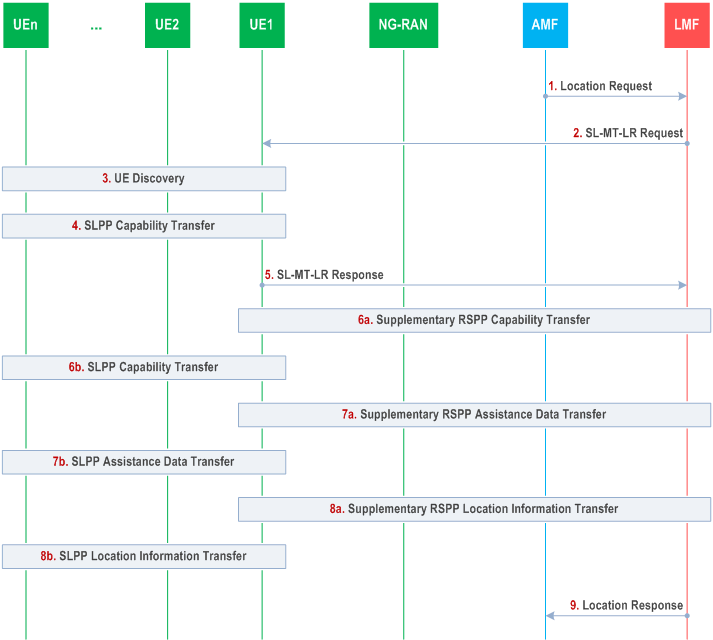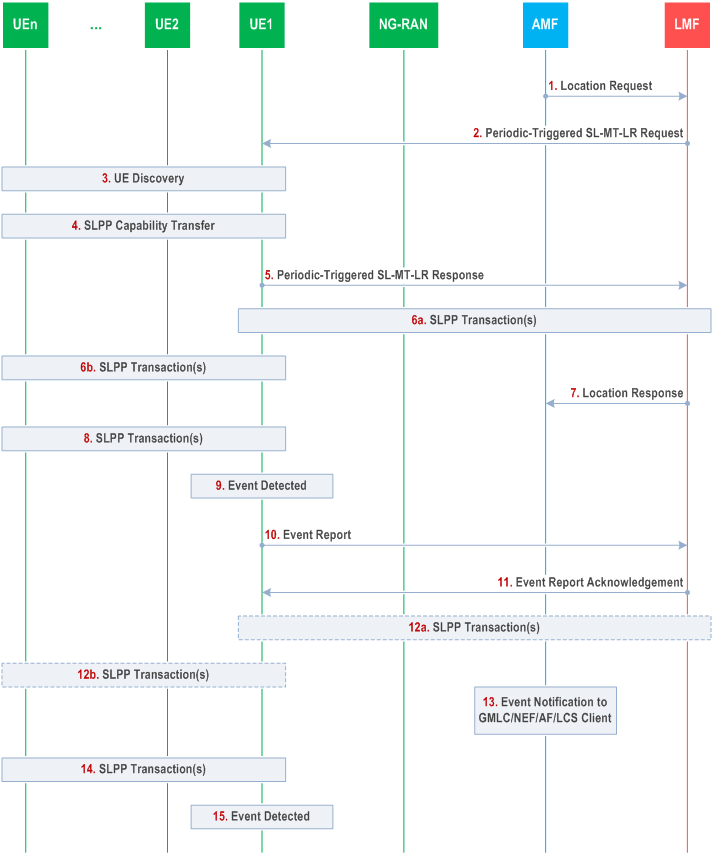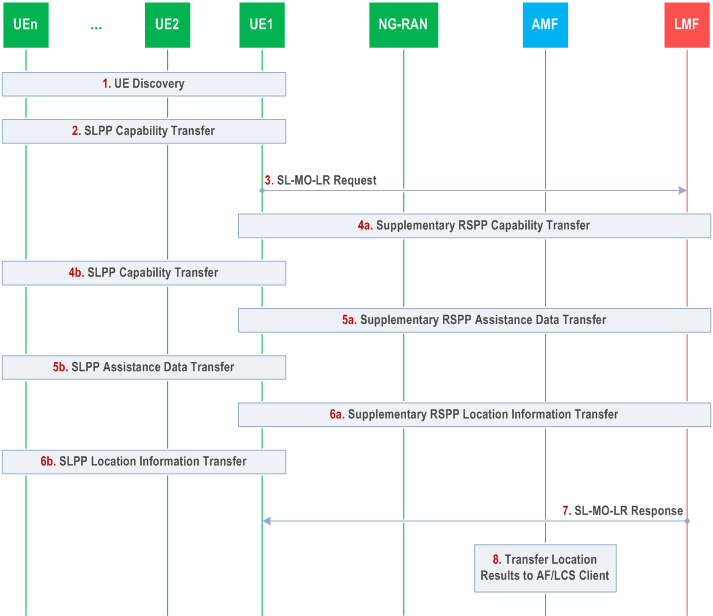Content for TS 38.305 Word version: 18.3.0
1…
4…
5…
6…
6.5…
6.7…
7…
7.3A…
7.4…
7.6…
7.11…
7.12…
8…
8.1.2.1a…
8.1.3…
8.2…
8.3…
8.4…
8.5…
8.6…
8.7…
8.8…
8.9…
8.10…
8.11…
8.12…
8.13…
8.14…
8.15…
A…
7.3A Service Layer Support for Sidelink Positioning
7.3A.1 General
7.3A.2 SL-MT-LR Service Support
7.3A.3 SL-MT-LR Service Support for periodic, triggered Location Events
7.3A.4 SL-MO-LR Service Support
...
...
7.3A Service Layer Support for Sidelink Positioning |R18| p. 50
7.3A.1 General p. 50
As described in TS 23.273, UE-positioning-related services can be instigated from the 5GC for an SL-MT-LR location service to obtain ranging/sidelink positioning location results for a group of UEs, or from the UE in case of an SL-MO-LR location service to obtain sidelink positioning/ranging location results using one or more other UEs with the assistance of an LMF. The complete sequence of operations in the 5GC is defined in TS 23.273. This clause defines the overall sequences of operations that occur in the LMF and UE.
7.3A.2 SL-MT-LR Service Support p. 50
Figure 7.3A.2-1 shows the sequence of operations for an SL-MT-LR location service, starting at the point where the AMF initiates the service in the LMF.

Step 1.
The AMF serving UE1 sends a location request to the LMF including information on the required location results of the n UEs (e.g., absolute location, relative location or ranges and directions between pairs of UE(s)), the required LCS QoS and the Application Layer IDs of the UEs when available, as described in TS 23.273.
Step 2.
The LMF sends an SL-MT-LR request to UE1 (via serving AMF) including the types of required location results (e.g., absolute location, relative locations or distances and/or directions) and the Application Layer IDs of the other UEs 2 to n.
Step 3.
UE1 attempts to discover the other UEs 2 to n using their Application Layer IDs if not already discovered, as described in TS 23.273.
Step 4.
UE1 obtains the sidelink positioning capabilities of the discovered UEs using the SLPP capability transfer procedures specified in clause 7.11.2.1.
Step 5.
UE1 returns a SL-MT-LR Response to the LMF (via serving AMF) indicating which of the UEs 2 to n have been discovered and the sidelink positioning capabilities of the discovered UEs, if obtained.
Step 6a.
The LMF may send a SLPP Request Capabilities message to UE1 to request the SL positioning and ranging capabilities of UE1 as described in clause 7.11.2.1.
Step 6b.
The LMF may request from UE1 the SL positioning and ranging capabilities of UEs 2 to n using the Supplementary RSPP Procedure. The Supplementary RSPP message includes embedded SLPP Request Capabilities messages for UEs 2 to n together with their Application Layer IDs.
Step 6c.
UE1 may instigate the SLPP Capability Transfer procedure specified in clause 7.11.2.1 with UEs 2 to n to obtain the sidelink positioning capabilities for UEs 2 to n, if not already obtained (e.g., at step 4).
Step 6d.
UE1 may provide its SL positioning and ranging capabilities as requested at step 6a to the LMF in a SLPP Provide Capabilities message.
Step 6e.
UE1 may provide the SL positioning and ranging capabilities of UEs 2 to n as requested at step 6b to the LMF using the Supplementary RSPP Procedure. The Supplementary RSPP message includes embedded SLPP Provide Capabilities messages from UEs 2 to n together with their Application Layer IDs.
Step 7a.
UE1 may send a SLPP Request Assistance Data message to the LMF to request SL positioning assistance data.
Step 7b.
UE1 may request SL positioning assistance data for UEs 2 to n using the Supplementary RSPP Procedure. The Supplementary RSPP message includes embedded SLPP Request Assistance Data messages for UEs 2 to n together with their Application Layer IDs.
Step 7c.
The LMF may send a SLPP Provide Assistance Data message to UE1.
Step 7d.
The LMF may provide assistance data for UEs 2 to n to UE1 using the Supplementary RSPP Procedure. The Supplementary RSPP message includes embedded SLPP Provide Assistance Data messages for UEs 2 to n together with their Application Layer IDs.
Step 7e.
UE1 may instigate the SLPP Assistance Data Transfer procedure specified in clause 7.11.2.2 with UEs 2 to n to provide the received assistance data from step 7d to the UEs 2 to n. The assistance data may assist UEs 1 to n to obtain sidelink location measurements and/or may assist UE1 to calculate sidelink positioning/ranging location results.
Step 8a.
The LMF sends a SLPP Request Location Information message to UE1. The request may include an indication whether location calculation should be performed by the UE (SL Target UE-based), or whether location measurements should be provided for location calculation at the LMF (SL Target UE-assisted).
Step 8b.
The LMF may request location information from UEs 2 to n using the Supplementary RSPP Procedure. The Supplementary RSPP message includes embedded SLPP Request Location Information messages for UEs 2 to n together with their Application Layer IDs.
Step 8c.
UE1 instigates the SLPP Location Information Transfer procedure specified in clause 7.11.2.3 among UEs 1 to n in which UE1 to n obtain sidelink location measurements and UEs 2 to n transfer their sidelink location measurements to UE1.
Step 8d.
UE1 sends a SLPP Provide Location Information message to the LMF with the location information requested at step 8a.
Step 8e.
UE1 provides the location information requested at step 8b for UEs 2 to n to the LMF using the Supplementary RSPP Procedure. The Supplementary RSPP message includes embedded SLPP Provide Location Information messages for UEs 2 to n together with their Application Layer IDs.
Step 9.
The LMF returns a location response to the AMF with any sidelink positioning/ranging location results obtained as a result of steps 6 to 8.
7.3A.3 SL-MT-LR Service Support for periodic, triggered Location Events p. 52
Figure 7.3A.3-1 shows the sequence of operations for an SL-MT-LR location service for periodic and triggered location events, starting at the point where the AMF initiates the service in the LMF.

Step 1.
The AMF serving UE1 sends a location request to the LMF to request periodic or triggered sidelink positioning/ranging location results of the n UEs (e.g., absolute locations, relative location or ranges and directions between pairs of UE(s)). The request includes information on the time interval between successive location reports, the total number of reports, and/or the details of the trigger event (e.g., change of location or ranges), the SUPI of UE1, the required LCS QoS and the Application Layer IDs of the UEs when available, as described in TS 23.273.
Step 2.
The LMF sends a Periodic-Triggered SL-MT-LR request to UE1 (via serving AMF) including the information of the periodic or triggered event, the types of required location results (e.g., absolute location, relative locations or distances and/or directions) and the Application Layer IDs of the other UEs 2 to n.
Step 3.
UE1 attempts to discover the other UEs 2 to n using their Application Layer IDs if not already discovered, as described in TS 23.273.
Step 4.
UE1 obtains the sidelink positioning capabilities of the discovered UEs using the SLPP capability transfer procedures specified in clause 7.11.2.1.
Step 5.
UE1 returns a Periodic-Triggered SL-MT-LR Response to the LMF (via serving AMF) indicating which of the UEs 2 to n have been discovered, whether the UEs 1 to n accept the periodic or triggered location request, and the sidelink positioning capabilities of the discovered UEs, if obtained.
Step 6a.
The LMF may instigate one or more SLPP and Supplementary RSPP procedures with UE1 to transfer sidelink positioning capabilities for UEs 1 to n, to transfer SLPP assistance data for UEs 1 to n, and to transfer sidelink location information for UEs 1 to n (e.g., sidelink ranging and/or location measurements or location estimates obtained at step 6b), as described in steps 6a/b/d/e, 7a/b/c/d, and 8a/b/d/e in Figure 7.3A.2-1.
Step 6b.
UE1 may instigate one or more SLPP procedures among UEs 1 to n to transfer sidelink positioning capabilities, provide sidelink assistance data to the UEs 2 to n, and/or obtain sidelink location information for UEs 1 to n (e.g., sidelink ranging and/or location measurements or location estimates) as described in steps 6c, 7e, and 8c in Figure 7.3A.2-1.
Step 7.
The LMF returns a location response to the AMF indicating that the SL-MT-LR for periodic, triggered Location Events has been successfully initiated and with any initial sidelink positioning/ranging location results obtained as a result of steps 6.
Step 8.
The UEs 1 to n may periodically perform sidelink positioning/ranging in order to support steps 9 and 10. The UE may perform steps 6c, 7e, and 8c in Figure 7.3A.2-1.
Step 9.
The UE monitors for occurrence of the trigger or periodic event requested at step 2.
Step 10.
UE1 sends an event report message to the LMF (via serving AMF) indicating the type of event being reported and may include sidelink location results obtained at step 8.
Step 11.
The LMF (via serving AMF) returns an event report acknowledgement to UE1.
Step 12.
If sidelink location results are needed for event reporting and not received at step 10, the LMF may instigate one or more SLPP and Supplementary RSPP procedures with UE1 as described in step 6a/6b.
Step 13.
The LMF returns the event report and any sidelink location results to the LCS Client or AF.
Step 14.
The UEs 1 to n continue to periodically perform sidelink positioning/ranging as in step 8.
Step 15.
The UE1 continues to monitor for further periodic or trigger events as in step 9 and instigates steps 10-12 each time a periodic or trigger event is detected.
7.3A.4 SL-MO-LR Service Support p. 54
Figure 7.3A.4-1 shows the sequence of operations for an SL-MO-LR service instigated by UE1 to obtain sidelink positioning/ranging location results using one or more other UEs with the assistance of an LMF.

Step 1.
Based on a trigger of service request (e.g., received from the application layer in UE1) UE1 discovers the other UEs 2 to n, as described in TS 23.273.
Step 2.
UE1 may obtain the sidelink positioning capabilities of the discovered UEs using the SLPP capability transfer procedures specified in clause 7.11.2.1.
Step 3.
UE1 sends an SL-MO-LR Request to the LMF via the serving AMF, including the Application Layer IDs of the other UEs 2 to n together with an indication on any sidelink assistance data needed, position calculation assistance from the LMF needed, and/or whether location results should be transferred to an LCS client or AF. For position calculation assistance from the LMF, the SL-MO-LR Request may include information on the type of sidelink positioning/ranging location results (e.g., absolute location, relative location or distances and directions between pairs of UEs) and desired QoS.
Step 4a.
The LMF may send a SLPP Request Capabilities message to UE1 to request the SL positioning and ranging capabilities of UE1 as described in clause 7.11.2.1.
Step 4b.
The LMF may request from UE1 the SL positioning and ranging capabilities of UEs 2 to n using the Supplementary RSPP Procedure. The Supplementary RSPP message includes embedded SLPP Request Capabilities messages for UEs 2 to n together with their Application Layer IDs.
Step 4c.
UE1 may instigate the SLPP Capability Transfer procedure specified in clause 7.11.2.1 with UEs 2 to n to obtain the sidelink positioning capabilities for UEs 2 to n, if not already obtained (e.g., at step 2).
Step 4d.
UE1 may provide its SL positioning and ranging capabilities as requested at step 4a to the LMF in a SLPP Provide Capabilities message.
Step 4e.
UE1 may provide the SL positioning and ranging capabilities of UEs 2 to n as requested at step 4b to the LMF using the Supplementary RSPP Procedure. The Supplementary RSPP message includes embedded SLPP Provide Capabilities messages from UEs 2 to n together with their Application Layer IDs.
Step 5a.
UE1 may send a SLPP Request Assistance Data message to the LMF to request SL positioning assistance data, if this request was not already included at step 3.
Step 5b.
UE1 may request SL positioning assistance data for UEs 2 to n using the Supplementary RSPP Procedure, if this request was not already included at step 3. The Supplementary RSPP message includes embedded SLPP Request Assistance Data messages for UEs 2 to n together with their Application Layer IDs.
Step 5c.
The LMF may send a SLPP Provide Assistance Data message to UE1.
Step 5d.
The LMF may provide assistance data for UEs 2 to n to UE1 using the Supplementary RSPP Procedure. The Supplementary RSPP message includes embedded SLPP Provide Assistance Data messages for UEs 2 to n together with their Application Layer IDs.
Step 5e.
UE1 may instigate the SLPP Assistance Data Transfer procedure specified in clause 7.11.2.2 with UEs 2 to n to provide the received assistance data from step 5d to the UEs 2 to n. The assistance data may assist UEs 1 to n to obtain sidelink location measurements and/or may assist UE1 to calculate sidelink positioning/ranging location results.
Step 6a.
If UE1 requested position calculation assistance from the LMF or location transfer to an LCS client or AF at step 3, the LMF sends a SLPP Request Location Information message to UE1. The request may include an indication whether location calculation should be performed by the UE (SL Target UE-based), or whether location measurements should be provided for location calculation at the LMF (SL Target UE-assisted).
Step 6b.
If UE1 requested position calculation assistance from the LMF or location transfer to an LCS client or AF at step 3 and if location measurements are required from UEs 2 to n, the LMF requests the location information using the Supplementary RSPP Procedure. The Supplementary RSPP message includes embedded SLPP Request Location Information messages for UEs 2 to n together with their Application Layer IDs.
Step 6c.
UE1 instigates the SLPP Location Information Transfer procedure specified in clause 7.11.2.3 among UEs 1 to n in which UE1 to n obtain sidelink location measurements and UEs 2 to n transfer their sidelink location measurements to UE1.
Step 6d.
UE1 sends a SLPP Provide Location Information message to the LMF with the location information requested at step 6a.
Step 6e.
UE1 provides the location information requested at step 6b for UEs 2 to n to the LMF using the Supplementary RSPP Procedure. The Supplementary RSPP message includes embedded SLPP Provide Location Information messages for UEs 2 to n together with their Application Layer IDs.
Step 7.
The LMF sends a SL-MO-LR Response to the AMF which forwards the SL-MO-LR Response to UE1. If UE1 requested position calculation assistance at step 3, the SL-MO-LR Response includes the calculated UE locations obtained from step 6.
Step 8.
If requested at step 3, the AMF provides the location results to the AF/LCS Client.